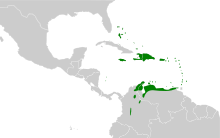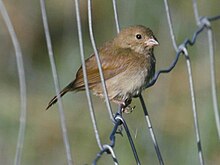| Black-faced grassquit | |
|---|---|

| |
| Male, Jamaica | |

| |
| Female, Jamaica | |
| Conservation status | |
 Least Concern (IUCN 3.1) | |
| Scientific classification | |
| Domain: | Eukaryota |
| Kingdom: | Animalia |
| Phylum: | Chordata |
| Class: | Aves |
| Order: | Passeriformes |
| Family: | Thraupidae |
| Genus: | Melanospiza |
| Species: | M. bicolor |
| Binomial name | |
| Melanospiza bicolor (Linnaeus, 1766) | |

| |
| Synonyms | |
| |
The black-faced grassquit (Melanospiza bicolor) is a small bird. It is recognized as a tanager closely related to Darwin's finches. It breeds in the West Indies except Cuba, on Tobago but not Trinidad, and along the northern coasts of Colombia and Venezuela.
Taxonomy
The first formal description of the black-faced grassquit was by the Swedish naturalist Carl Linnaeus in 1766 in the twelfth edition of his Systema Naturae. He introduced the binomial name Fringilla bicolor. Linnaeus based his description on the "Bahama Sparrow" that was described and illustrated by Mark Catesby in his The Natural History of Carolina, Florida and the Bahama Islands which was published between 1729 and 1732. The black-faced grassquit was traditionally placed in the genus Tiaris. A molecular phylogenetic study published in 2014 found that this genus was polyphyletic and that the black-faced grassquit was closely related to the Saint Lucia black finch in the monospecific genus Melanospiza. In the resulting reorganization of the genera, the black-faced grassquit was moved to Melanospiza.

Eight subspecies are recognised:
- M. b. bicolor (Linnaeus, 1766) – Bahamas and islands off north Cuba
- M. b. marchii (Baird, SF, 1864) – Jamaica and Hispaniola
- M. b. omissa (Jardine, 1847) – Puerto Rico, Lesser Antilles, north Colombia and north Venezuela
- M. b. huilae (Miller, AH, 1952) – central Colombia
- M. b. grandior (Cory, 1887) – San Andrés Archipelago (east of Nicaragua)
- M. b. johnstonei (Lowe, 1906) – La Blanquilla Island and the Los Hermanos Archipelago (off north Venezuela)
- M. b. sharpei (Hartert, 1893) – Netherlands Antilles
- M. b. tortugensis (Cory, 1909) – La Tortuga Island (off north Venezuela)
Description
A male black-faced grassquit is around 10 cm (3.9 in) long and weighs approximately 10 g (0.35 oz). It has a short conical black bill, a black head and breast, and an olive green back. Females and immature birds have dull olive-grey upperparts and head, and paler grey underparts becoming whiter on the belly.
Males on the South American mainland have more extensively black underparts, shading to a grey belly.
The male has a display flight in which he flies for short distances, vibrating his wings and giving a buzzing dik-zeezeezee call.
Behaviour and ecology
Breeding
This is a common bird in long grass or scrub in open or semi-open areas, including roadsides and ricefields. It makes a domed grass nest, lined with finer grasses, and placed low in a bush or on a bank. The typical clutch is two or three whitish eggs blotched with reddish brown.
Food and feeding
The black-faced grassquit feeds mainly on seeds, especially of grasses and weeds, occasionally on fruits and berries. It also feeds on small insects, mainly during the breeding season. It is often found in small groups.
References
- BirdLife International (2018). "Melanospiza bicolor". IUCN Red List of Threatened Species. 2018: e.T22723611A132167813. doi:10.2305/IUCN.UK.2018-2.RLTS.T22723611A132167813.en. Retrieved 12 November 2021.
- Linnaeus, Carl (1766). Systema naturae : per regna tria natura, secundum classes, ordines, genera, species, cum characteribus, differentiis, synonymis, locis (in Latin). Vol. 1, Part 1 (12th ed.). Holmiae (Stockholm): Laurentii Salvii. p. 324.
- Catesby, Mark (1729–1732). The Natural History of Carolina, Florida and the Bahama Islands (in English and French). Vol. 1. London: W. Innys and R. Manby. p. 37, Plate 37.
- Paynter, Raymond A. Jr, ed. (1970). Check-List of Birds of the World. Vol. 13. Cambridge, Massachusetts: Museum of Comparative Zoology. p. 156.
- Burns, K.J.; Shultz, A.J.; Title, P.O.; Mason, N.A.; Barker, F.K.; Klicka, J.; Lanyon, S.M.; Lovette, I.J. (2014). "Phylogenetics and diversification of tanagers (Passeriformes: Thraupidae), the largest radiation of Neotropical songbirds". Molecular Phylogenetics and Evolution. 75: 41–77. Bibcode:2014MolPE..75...41B. doi:10.1016/j.ympev.2014.02.006. PMID 24583021.
- Burns, K.J.; Unitt, P.; Mason, N.A. (2016). "A genus-level classification of the family Thraupidae (Class Aves: Order Passeriformes)". Zootaxa. 4088 (3): 329–354. doi:10.11646/zootaxa.4088.3.2. PMID 27394344.
- ^ Gill, Frank; Donsker, David; Rasmussen, Pamela, eds. (July 2020). "Tanagers and allies". IOC World Bird List Version 10.2. International Ornithologists' Union. Retrieved 12 November 2020.
- ^ Rising, J.D. (2020). del Hoyo, J.; Elliott, A.; Sargatal, J.; Christie, D.A.; de Juana, E. (eds.). "Black-faced Grassquit (Melanospiza bicolor), version 1.0". Birds of the World. Ithaca, NY, USA: Cornell Lab of Ornithology. doi:10.2173/bow.bkfgra.01. S2CID 216425936. Retrieved 14 November 2020.
- ^ Hailey, Adrian (ed.). "Tiaris bicolor (Black-faced Grassquit)" (PDF). The Online Guide to the Animals of Trinidad and Tobago. St. Augustine: Department of Life Sciences, The University of the West Indies, St Augustine.
External links
- Xeno-canto: audio recordings of the black-faced grassquit
- Black-faced Grassquit videos, photos & sounds on the Internet Bird Collection
| Taxon identifiers | |
|---|---|
| Melanospiza bicolor | |
| Tiaris bicolor |
|
| Fringilla bicolor | |